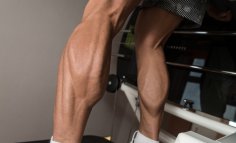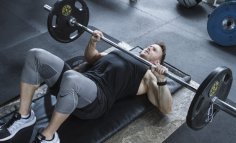2 THE TWO LIFTS
2.1 The Snatch
2.1.1 The barbell is placed horizontally in front of the lifter's legs. It is gripped, palms downwards and pulled in a single movement from the platform to the full extent of both arms above the head, while either splitting or bending the legs. During this continuous movement, the barbell may slide along the thighs and the lap. No part of the body other than the feet may touch the platform during the execution of the lift. The weight, which has been lifted, must be maintained in the final motionless position, arms and legs extended, the feet on the same line, until the referees give the signal to replace the barbell on the platform. The lifter may recover in his or her own time, either from a split or a squat position, and finish with the feet on the same line, parallel to the plane of the trunk and the barbell. The referees give the signal to lower the barbell as soon as the lifter becomes motionless in all parts of the body.
2.2 The Clean and Jerk
2.2.1 The first part, the Clean:
The barbell is placed horizontally in front of the lifter's legs. It is gripped, palms downwards and pulled in a single movement from the platform to the shoulders, while either splitting or bending the legs. During this continuous movement, the barbell may slide along the thighs and the lap. The barbell must not touch the chest before the final position. It then rests on the clavicles or on the chest above the nipples or on the arms fully bent. The feet return to the same line, legs straight before performing the Jerk. The lifter may make this recovery in his or her own time and finish with the feet on the same line, parallel to the plane of the trunk and the barbell.
2.2.2 The second part, the Jerk:
The athlete bends the legs and extends them as well as the arms to bring the barbell to the full stretch of the arms vertically extended. He or she returns the feet to the same line; arms and legs fully extended, and waits for the referees' signal to replace the barbell on the platform. The referees give the signal to lower the barbell as soon as the lifter becomes motionless in all parts of the body.
IMPORTANT REMARK:
After the Clean and before the Jerk, the lifter may adjust the position of the barbell. This must not lead to confusion. It does not mean the granting of an additional jerk attempt but allowing the lifter to:
a) withdraw the thumbs or “unhook” if this method is used,
b) lower the barbell in order to let it rest on the shoulders if the barbell is placed too high and impedes the breathing or causes pain,
c) change the width of the grip.
2.3 General rules for all lifts
2.3.1 The technique known as “hooking” is permitted. It consists of covering the last joint of the thumb with the other fingers of the same hand at the moment of gripping the barbell.
2.3.2 In all lifts, the referees must count as “No lift” any unfinished attempt in which the barbell has reached the height of the knees.
2.3.3 After the referees signal to lower the barbell, the lifter must lower it in front of the body and not let it drop either deliberately or accidentally. The grip on the barbell may be released when it has passed the level of the waist.
2.3.4 A competitor, who cannot fully extend the elbow due to an anatomical deformation, must report this fact to the three referees and the Jury before the start of the competition.
2.3.5 When snatching or cleaning in the squat style, the lifter may help the recovery by making swinging and rocking movements of the body.
2.3.6 The use of grease, oil, water, talcum or any similar lubricant on the thighs is forbidden. Lifters are not permitted to have any substance on their thighs when arriving in the competition area. A lifter who uses any lubricant is ordered to remove it. During the removal the clock goes on.
2.3.7 The use of chalk (magnesium) on the hands, thighs, etc., is permitted.
2.4 Incorrect movements and positions for all lifts
2.4.1 Pulling from the hang.
2.4.2 Touching the platform with any part of the body other than the feet.
2.4.3 Uneven or incomplete extension of the arms, at the finish of the lift.
2.4.4 Pause during the extension of the arms.
2.4.5 Finishing with a press-out.
2.4.6 Bending and extending the elbows during the recovery.
2.4.7 Leaving the platform during the execution of the lift, i.e. touching the area outside the platform with any part of the body.
2.4.8 Replacing the barbell on the platform before the referees' signal.
2.4.9 Dropping the barbell after the referees' signal.
2.4.10 Failing to finish with the feet and the barbell in line and parallel to the plane of the trunk.
2.4.11 Failing to replace the complete barbell on the platform, i.e. the complete barbell must first touch the platform.
2.5 Incorrect movements for the Snatch
2.5.1 Pause during the lifting of the barbell.
2.5.2 Touching the head of the lifter with the bar.
2.6 Incorrect movements for the Clean
2.6.1 Placing the bar on the chest before turning the elbows.
2.6.2 Touching the thighs or the knees with the elbows or the upper arms.
2.7 Incorrect movements for the Jerk
2.7.1 Any apparent effort of jerking which is not completed. This includes lowering the body or bending the knees.
2.7.2 Any deliberate oscillation of the barbell to gain advantage. The athlete and the barbell have to become motionless before starting the jerk.
















